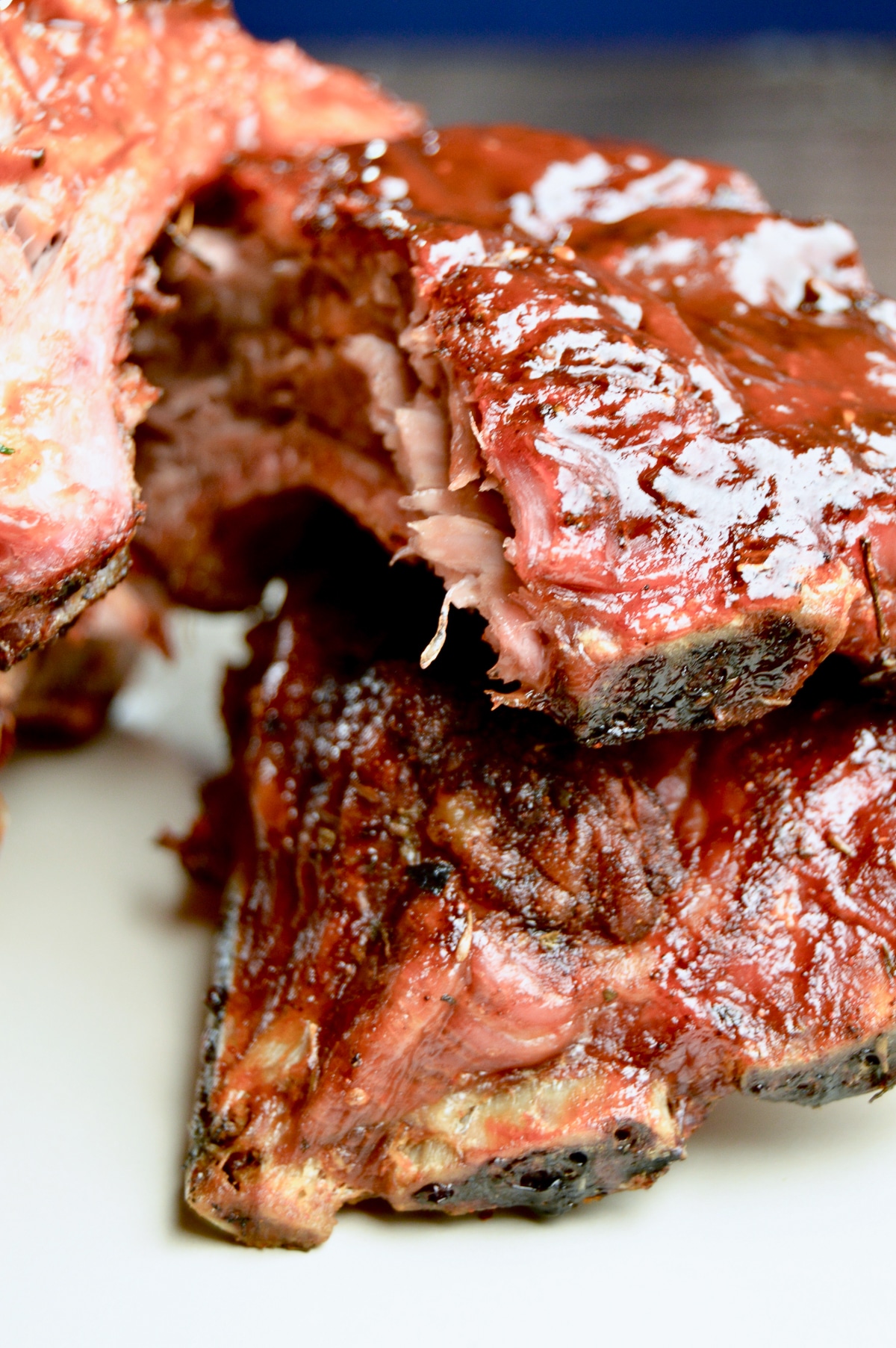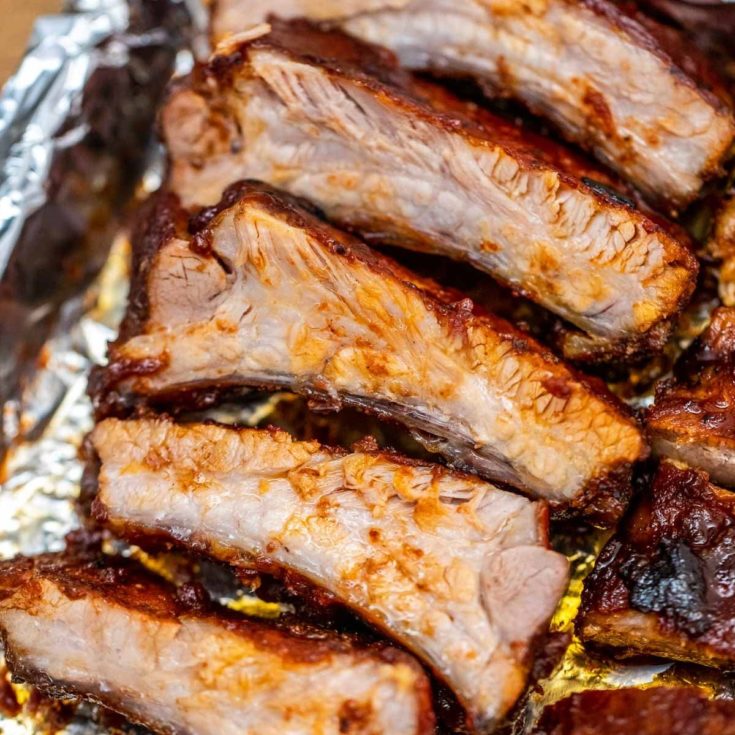Video tentang The Ultimate Guide to Baked BBQ Ribs: From Fall-Off-the-Bone Tender to Mouthwatering Glaze
The Ultimate Guide to Baked BBQ Ribs: From Fall-Off-the-Bone Tender to Mouthwatering Glaze

Baked BBQ ribs. The very phrase conjures images of succulent, tender meat, glistening with a sticky, smoky BBQ glaze, falling off the bone with the slightest touch. While the smoky allure of ribs cooked low and slow on a smoker is undeniable, baking offers a convenient and equally delicious alternative, perfect for weeknight meals or larger gatherings where smoker space might be limited. This comprehensive guide will delve into every aspect of creating unforgettable baked BBQ ribs, from selecting the perfect rack to achieving that coveted, melt-in-your-mouth texture.
Choosing Your Ribs:
The foundation of any great BBQ rib recipe lies in the quality of the ribs themselves. Understanding the differences between rib types is crucial for success. Primarily, you’ll encounter two main options:
-
Baby Back Ribs: These ribs are smaller, more tender, and generally considered sweeter. They come from the back of the pig, closer to the spine, and have a thinner layer of meat compared to spare ribs. Their smaller size translates to faster cooking times, making them a popular choice for home cooks.
-
Spare Ribs: These ribs are larger, meatier, and often have a more pronounced, savory flavor. They originate from the belly of the pig and contain a thicker layer of meat, along with a tougher membrane on the bone side. While requiring longer cooking times, spare ribs deliver a more substantial and robust eating experience.

For beginners, baby back ribs are often recommended due to their shorter cooking time and inherent tenderness. However, don’t shy away from spare ribs – with the right technique, they can yield incredibly flavorful and satisfying results.
Preparing the Ribs: The Crucial First Steps
Before even thinking about the BBQ sauce, proper preparation is paramount to achieving tender, flavorful ribs. This process involves several key steps:
-
Removing the Membrane: The tough membrane on the bone side of spare ribs (and sometimes baby backs) needs to be removed. This membrane prevents the ribs from absorbing moisture and becoming tender. Use a butter knife or your fingers to carefully peel it back from one corner, then work your way across the entire surface.
-
Trimming Excess Fat: While fat contributes to flavor, excessive fat can render the ribs greasy. Trim away any large chunks of visible fat, but leave a thin layer for moisture and flavor.

-
Seasoning: This is where you can truly customize your ribs. A simple dry rub is often the best approach. A classic combination includes brown sugar, paprika, garlic powder, onion powder, chili powder, salt, and black pepper. Experiment with different spice blends to find your favorite profile – consider adding cumin, cayenne pepper, or even smoked paprika for a deeper flavor. Generously rub the seasoning into both sides of the ribs, ensuring complete coverage.

The Baking Process: Low and Slow for Maximum Tenderness
Baking ribs involves a low and slow approach, similar to smoking, but with the convenience of your oven. Here’s a detailed breakdown:
-
The Wrap: Wrapping the ribs in foil during a portion of the cooking process helps to trap moisture and accelerate the tenderizing process. This "Texas Crutch" method is highly effective. After about 1.5-2 hours of baking (depending on the rib type and thickness), remove the ribs from the oven, wrap them tightly in heavy-duty aluminum foil, and return them to the oven. This will continue to cook the ribs, breaking down collagen and rendering them incredibly tender.
-
The Unwrap and Glaze: After another hour or so of wrapped baking, carefully remove the ribs from the foil. The ribs should be significantly more tender at this point. Now it’s time to apply your BBQ sauce. Brush a generous layer of your favorite BBQ sauce over the ribs, ensuring even coverage.
-
The Final Bake (Optional): For a beautifully glazed and caramelized finish, return the ribs to the oven unwrapped for the final 15-20 minutes. This allows the sauce to thicken and develop a rich, glossy surface. Keep a close eye on them to prevent burning.
BBQ Sauce Selection: A Matter of Taste
The choice of BBQ sauce is entirely a matter of personal preference. From tangy vinegar-based sauces to sweet and smoky tomato-based sauces, the possibilities are endless. Consider these options:
- Kansas City Style: Tomato-based, sweet and smoky, often with a hint of molasses.
- Carolina Style: Vinegar-based, tangy and slightly spicy.
- Memphis Style: Tomato-based, dry rub-heavy, with a balance of sweet and savory.
- Texas Style: Tomato-based, slightly spicy, often with a mustard base.
You can purchase pre-made sauces or create your own from scratch. Experiment with different ingredients like Worcestershire sauce, brown sugar, apple cider vinegar, and your favorite spices to create a unique flavor profile.
Temperature and Time Considerations:
The cooking time for baked BBQ ribs varies depending on the type of ribs and your oven. As a general guideline:
-
Baby Back Ribs: Bake at 275°F (135°C) for approximately 2-2.5 hours, then wrap and bake for another 1-1.5 hours. Finally, unwrap and glaze for 15-20 minutes.
-
Spare Ribs: Bake at 275°F (135°C) for approximately 3-3.5 hours, then wrap and bake for another 1.5-2 hours. Finally, unwrap and glaze for 15-20 minutes.
Always use a meat thermometer to ensure the ribs reach an internal temperature of 190-200°F (88-93°C) for optimal tenderness. Remember that oven temperatures can vary, so adjust cooking times as needed.
Serving Suggestions:
Once your baked BBQ ribs are cooked to perfection, let them rest for 10-15 minutes before slicing and serving. This allows the juices to redistribute, resulting in even more tender and flavorful meat. Serve them with classic sides like coleslaw, potato salad, corn on the cob, or baked beans for a complete BBQ feast.
Troubleshooting Common Problems:
-
Dry Ribs: If your ribs are dry, you likely didn’t wrap them long enough or your oven temperature was too high. Ensure you’re using the wrapping method and maintaining a low and slow cooking temperature.
-
Tough Ribs: If your ribs are tough, they may not have cooked long enough. Use a meat thermometer to check the internal temperature and continue baking until it reaches the desired temperature.
-
Burnt Ribs: If your ribs are burnt, your oven temperature was likely too high or you left them unwrapped for too long during the glazing stage. Monitor your ribs closely and adjust the temperature or cooking time as needed.
Conclusion:
Baking BBQ ribs offers a delicious and accessible alternative to traditional smoking methods. By following these steps and tips, you can create fall-off-the-bone tender, mouthwatering ribs that will impress your family and friends. Remember that the key to success lies in proper preparation, a low and slow cooking approach, and the use of a meat thermometer to ensure perfect doneness. So fire up your oven, gather your ingredients, and prepare for a truly unforgettable BBQ experience. Happy cooking!

Penutup
Therefore, we hope this article has provided valuable insights on The Ultimate Guide to Baked BBQ Ribs: From Fall-Off-the-Bone Tender to Mouthwatering Glaze. We hope you found this article informative and helpful. See you in our next article!

